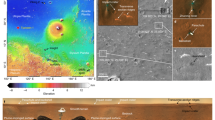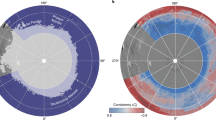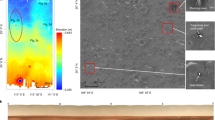Abstract
Comprehensive analyses of remote sensing data during the three-year effort to select the Mars Exploration Rover landing sites at Gusev crater and at Meridiani Planum correctly predicted the atmospheric density profile during entry and descent and the safe and trafficable surfaces explored by the two rovers. The Gusev crater site was correctly predicted to be a low-relief surface that was less rocky than the Viking landing sites but comparably dusty. A dark, low-albedo, flat plain composed of basaltic sand and haematite with very few rocks was expected and found at Meridiani Planum. These results argue that future efforts to select safe landing sites based on existing and acquired remote sensing data will be successful. In contrast, geological interpretations of the sites based on remote sensing data were less certain and less successful, which emphasizes the inherent ambiguities in understanding surface geology from remotely sensed data and the uncertainty in predicting exactly what materials will be available for study at a landing site.
This is a preview of subscription content, access via your institution
Access options
Subscribe to this journal
Receive 51 print issues and online access
$199.00 per year
only $3.90 per issue
Buy this article
- Purchase on Springer Link
- Instant access to full article PDF
Prices may be subject to local taxes which are calculated during checkout




Similar content being viewed by others
References
Golombek, M. P. et al. Selection of the Mars Exploration Rover landing sites. J. Geophys. Res. 108(E12), 8072, doi:10.1029/2003JE002074 (2003)
Cabrol, N. A., Grin, E. A. & Landheim, R. Ma'adim Vallis evolution: geometry and models of discharge rate. Icarus 132, 362–377 (1998)
Kuzmin, R., et al. Geologic map of the MTM-15182 and MTM-15187 quadrangles, Gusev crater-Ma'adim Vallis region, Mars. US Geol. Surv. Map I-2666 (US Geological Survey, Washington DC, 2000)
Arvidson, R. E. et al. Mantled and exhumed terrains in Terra Meridiani, Mars. J. Geophys. Res. 108(E12), 8073, doi:10.1029/2002JE001982 (2003)
Christensen, P. R. et al. Morphology and composition of the surface of Mars: Mars Odyssey THEMIS results. Science 300(5628), 2056–2061 (2003)
Christensen, P. R. & Ruff, S. W. Formation of the hematite-bearing unit in Meridiani Planum: evidence for deposition in standing water. J. Geophys. Res. 109, E08003, doi:10.1029/2003JE002233 (2004)
Arvidson, R. E. et al. Localization and physical properties experiments conducted by Spirit at Gusev crater. Science 305, 821–824 (2004)
Arvidson, R. E. et al. Localization and physical properties experiments conducted by Opportunity at Meridiani Planum. Science 306, 1730–1733 (2004)
Kass, D. M. et al. Analysis of atmospheric mesoscale models for entry, descent, and landing. J. Geophys. Res. 108(E12), 8090, doi:10.1029/2003JE002065 (2003)
Magalhaes, J. A., Schofield, J. T. & Seiff, A. Results of the Mars Pathfinder atmospheric structure investigation. J. Geophys. Res. 104, 8943–8956 (1999)
Smith, M. D. Interannual variability in TES atmospheric observations of Mars during 1999–2003. Icarus 167, 148–165 (2004)
Smith, D. E. et al. Mars Orbiter Laser Altimeter (MOLA): Experiment summary after the first year of global mapping of Mars. J. Geophys. Res. 106, 23689–23722 (2001)
Crisp, J. A. et al. Mars Exploration Rover mission. J. Geophys. Res. 108(E12), 8061, doi:10.1029/2002JE002038 (2003)
Christensen, P. R. & Moore, H. J. in Mars (eds Kieffer, H. H. et al.) 686–727 (Univ. Ariz. Press, Tucson, 1992)
Christensen, P. R. The spatial distribution of rocks on Mars. Icarus 68, 217–238 (1986)
Mellon, M. T., Jakosky, B. M., Kieffer, H. H. & Christensen, P. R. High-resolution thermal inertia mapping from the Mars Global Surveyor Thermal Emission Spectrometer. Icarus 148, 437–455 (2000)
Kieffer, H. H. et al. Thermal and albedo mapping of Mars during the Viking Primary Mission. J. Geophys. Res. 82, 4249–4291 (1977)
Fergason, R. L. & Christensen, P. R. Thermal inertia using THEMIS infrared data. Lunar Planet. Sci. XXIV abstr. 1785 (CD-ROM, Lunar and Planetary Institute, Houston, 2003)
Golombek, M. P. et al. Selection of the Mars Pathfinder landing site. J. Geophys. Res. 102, 3967–3988 (1997)
Presley, M. A. & Christensen, P. R. Thermal conductivity measurements of particulate materials. 2. Results. J. Geophys. Res. 102, 6551–6566 (1997)
Herkenhoff, K. E. et al. Textures of the soils and rocks at Gusev crater from Spirit's Microscopic Imager. Science 305(5685), 824–826 (2004)
Christensen, P. R. et al. Initial results from the Mini-TES experiment in Gusev crater from the Spirit rover. Science 305(5685), 837–842 (2004)
Moersch, J. E., et al. Comparison of orbital infrared observations and surface measurements by the Mars Exploration Rover Spirit at Gusev crater. Lunar Planet. Sci. XXXVI abstr. 2020 (CD-ROM, Lunar and Planetary Institute, Houston, 2005)
Herkenhoff, K. E. et al. Evidence for ancient water on Meridiani Planum from Opportunity's Microscopic Imager. Science 306, 1727–1730 (2004)
Bell, J. F. III et al. Pancam multispectral imaging results from the Spirit rover at Gusev crater. Science 305(5685), 800–806 (2004)
Ruff, S. W. & Christensen, P. R. Bright and dark regions on Mars: Particle size and mineralogical characteristics based on Thermal Emission Spectrometer data. J. Geophys. Res. 107(E12), 5127 doi:10.1029/2001JE001580 (2002)
Bell, J. F. et al. Pancam multispectral imaging results from the Opportunity rover at Meridiani Planum. Science 306, 1703–1709 (2004)
Golombek, M. et al. Rock size-frequency distributions on Mars and implications for MER landing safety and operations. J. Geophys. Res. 108(E12), 8086, doi:10.1029/2002JE002035 (2003)
Shepard, M. K. et al. The roughness of natural terrain: A planetary and remote sensing perspective. J. Geophys. Res. 106, 32777–32795 (2001)
Anderson, F. S. et al. Analysis of MOLA data for the Mars Exploration Rover landing sites. J. Geophys. Res. 108(E12), 8084, doi:10.1029/2003JE002125 (2003)
Kirk, R. et al. High-resolution topomapping of candidate MER landing sites with Mars Orbiter Camera narrow angle images. J. Geophys. Res. 108(E12), 8088, doi:10.1029/2003JE002131 (2003)
Moore, H. J. et al. Soil-like deposits observed by Sojourner, the Pathfinder rover. J. Geophys. Res. 104, 8729–8746 (1999)
Larsen, K. W., Haldemann, A. F. C., Jurgens, R. F. & Slade, M. A. Radar observations of recent Mars landing sites. Lunar Planet. Sci. XXXV abstr. 1050 (Lunar and Planetary Institute, Houston, 2004)
Hagfors, T. Backscattering from an undulating surface with applications to radar returns from the Moon. J. Geophys. Res. 69, 3779–3784 (1964)
Evans, J. V. & Hagfors, T. Radar Astronomy 620 (McGraw-Hill, New York, 1968)
Squyres, S. W. et al. In-situ evidence for an ancient aqueous environment on Mars. Science 306, 1709–1714 (2004)
Grant, J. A. et al. Surficial deposits at Gusev crater along Spirit rover traverses. Science 305, 807–810 (2004)
Squyres, S. W. et al. The Spirit rover's Athena science investigation at Gusev crater, Mars. Science 305, 794–799 (2004)
Castaño, R., et al. Autonomous onboard traverse science system. Proc. 2004 IEEE Aerospace Conf. (Big Sky, Montana, March 2004) abstr. 1375 (Institute of Electrical and Electronics Engineers, New York, NY, 2004)
Acknowledgements
We are deeply indebted to the MER engineers for offering us the opportunity to test our landing site predictions with data from the surface of Mars. We acknowledge the contributions of R. Blanchard, P. Withers and the MER Atmospheric Advisory Team to the interpretations of the atmospheric entry information. M. Wyatt provided the THEMIS thermal inertia image. R. Castano, A. Castano, B. Bornstein and R. C. Anderson developed OASIS, R. Deen provided panoramas and associated range at correct resolution, and T. Stough and M. Judd provided rock counts. Research described in this paper was done by the MER project, Jet Propulsion Laboratory, California Institute of Technology, under a contract with the National Aeronautics and Space Administration.
Author information
Authors and Affiliations
Corresponding author
Ethics declarations
Competing interests
Reprints and permissions information is available at npg.nature.com/reprintsandpermissions. The authors declare no competing financial interests.
Rights and permissions
About this article
Cite this article
Golombek, M., Arvidson, R., Bell, J. et al. Assessment of Mars Exploration Rover landing site predictions. Nature 436, 44–48 (2005). https://doi.org/10.1038/nature03600
Issue Date:
DOI: https://doi.org/10.1038/nature03600
This article is cited by
-
Results from InSight Robotic Arm Activities
Space Science Reviews (2023)
-
Site Detection for Autonomous Soft-Landing on Asteroids Using Deep Learning
Transactions of the Indian National Academy of Engineering (2021)
-
A Pre-Landing Assessment of Regolith Properties at the InSight Landing Site
Space Science Reviews (2018)
-
Geology and Physical Properties Investigations by the InSight Lander
Space Science Reviews (2018)
-
Impact-Seismic Investigations of the InSight Mission
Space Science Reviews (2018)
Comments
By submitting a comment you agree to abide by our Terms and Community Guidelines. If you find something abusive or that does not comply with our terms or guidelines please flag it as inappropriate.



